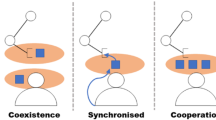abstract
The detection of a human’s intended behavior is one of the most important skills that a social robot should have in order to become acceptable as a part of human society, because humans are used to understand the actions of other humans in a goal-directed manner and they will expect the social robot to behave similarly. A breakthrough in this area can advance several research branches related to social intelligence such as learning by imitation and mutual adaptation. To achieve this goal the robot needs to integrate all possible evidence of intention and neglect the unintended behavior, and a complete solution should use low-level signal processing and high-level reasoning. This work explores the low-level signal processing part of the solution by proposing an interactive adaptive perception scheme that uses four important features of human behavior to amplify the signals originating from intended behavior with respect to signals originating from unintended behavior and other noise sources such as instrumental noise. This work follows the vision that intelligence is not only a function of a centralized sophisticated artificial brain, but can be presented in different forms in the entire robot including its perception and motion systems (the mind is not contained in the brain, but distributed in every cell in the body). A simple example of using the proposed scheme was implemented and the results of two experiments with it are also presented.











Similar content being viewed by others
References
Fong T, Nourbakhsh I, Dautenhahn K (2002) A survey of socially interactive robots: concepts, design, and applications. The Robotics Institute, Carnegie Mellon University, Pennsylvania CMU-RI-TR-02-29
Iba S (2004) Interactive multi-modal robot programming. PhD Thesis. Robotics Institute, Carnegie Mellon University, Pennsylvania
Lieberman J (2004) Teaching a robot manipulation skills through demonstration. Master Thesis. Department of Mechanical Engineering, MIT, Cambridge, MA
Schaal S (1999) Is imitation learning the route to humanoid robots? Trends Cogn Sci 3(6):233–242
Xu Y, Tajima T, Hatakeyama M, Yasuyuki S, Nishida T (2005) A two-layered approach to make human-robot interaction social and robust. In: AISB 2005 symposium on conversational informatics for supporting social intelligence and interaction, Hatfield, England, April 2005
Author information
Authors and Affiliations
Corresponding author
Rights and permissions
About this article
Cite this article
Mohammad, Y., Nishida, T. Interactive perception for amplification of intended behavior in complex noisy environments. AI & Soc 23, 167–186 (2009). https://doi.org/10.1007/s00146-007-0137-y
Received:
Accepted:
Published:
Issue Date:
DOI: https://doi.org/10.1007/s00146-007-0137-y




